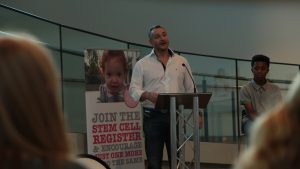
Presenting in the Map Area at City Hall, London, on 30 October 2017, alongside Jesse Panda (13) from Oasis Academy Waterloo, who followed my talk with Spoken Word
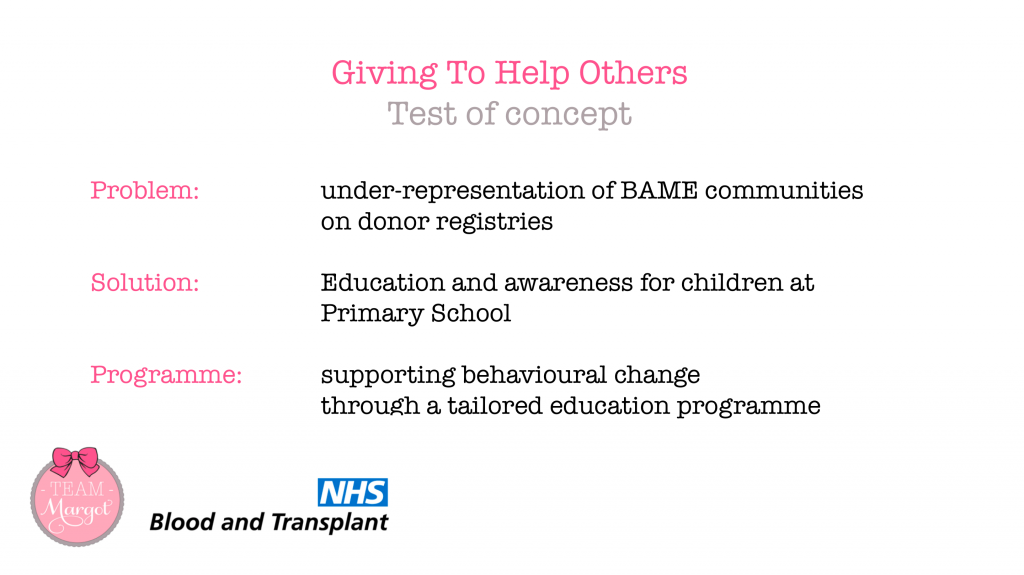 For much of this year, our attentions and efforts have been directed towards breathing life into an idea that we have been talking about for a while now: launching an education programme aimed at children of primary school ages, called ‘Giving to help others‘.
For much of this year, our attentions and efforts have been directed towards breathing life into an idea that we have been talking about for a while now: launching an education programme aimed at children of primary school ages, called ‘Giving to help others‘.
Problem: raising awareness of under-representation of BAME communities on donor registries
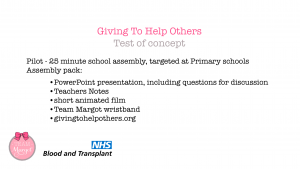 It is recognised that there’s a paucity of bone marrow/stem cell, blood and organ donors from the
It is recognised that there’s a paucity of bone marrow/stem cell, blood and organ donors from the
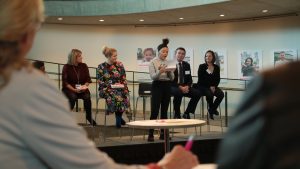
Elisha Rankin-Hart (13) from Queens Park Community School also spoke about her father having a kidney transplant
Black, Asian, Mixed Race & Minority Ethnic (BAME) communities. These communities are woefully under represented on the various UK registers and are the least engaged stakeholders. From the work that we are doing, we know that this problem is widely acknowledged and understood.
There are many organisations and community groups working hard to improve the situation and whilst there is progress being made, the cut through and engagement remains disappointing. Virtually all of this good work is aimed at adults (16+ years of age).
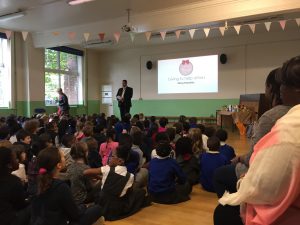
Head of School, Lorram Black, delivers the Giving to Help Others assembly to over 400 children at Dog Kennel Hill Primary School on 2 October 2017
Education and awareness for younger children
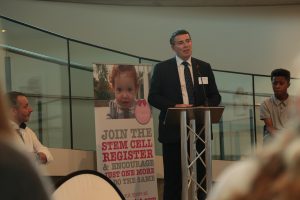
Ian Trenholm, CEO of NHS Blood and Transplant
We believe that there’s an opportunity to take a longer-term approach to this issue through education, targeted at children of primary school ages. If we can reach out to children whilst their minds are still relatively open and make them conscious & aware of how “giving to help others” can help save someone’s life, then we believe that the UK registers will make meaningful strides towards addressing these issues, in the longer term.
Programme: supporting behavioural change through a tailored education programme
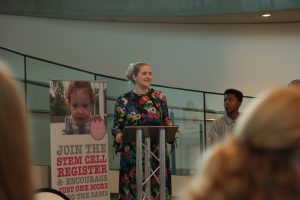
Josie Todd, Project Manager for London Curriculum, Greater London Authority
Working with children of primary school age, their teachers, parents and carers, our education 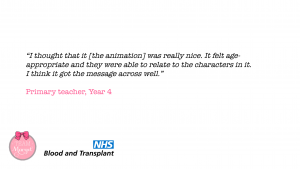 programme seeks to create & develop a dialogue for the issue of donation to be discussed in a safe and secure setting that is designed to engage young people at an appropriate level. The overarching objective in the longer term will be that greater engagement and awareness will result in an increase of the number and proportion of people from BAME communities becoming donors.
programme seeks to create & develop a dialogue for the issue of donation to be discussed in a safe and secure setting that is designed to engage young people at an appropriate level. The overarching objective in the longer term will be that greater engagement and awareness will result in an increase of the number and proportion of people from BAME communities becoming donors.
Our work is therefore aimed at developing the dialogue, tools and methodologies to an education programme that will:
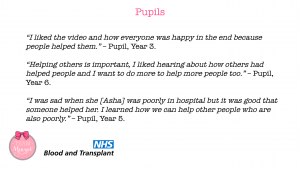 result in the children themselves being more informed of the good that being a donor can bring, how they can become a donor when the grow up and have reached the age of consent. The programme will aim to promote being a donor as the norm, rather than the exception
result in the children themselves being more informed of the good that being a donor can bring, how they can become a donor when the grow up and have reached the age of consent. The programme will aim to promote being a donor as the norm, rather than the exceptionSince February, we have been working with the fantastic people at Edcoms and Munro & Forster and more recently, Koop, in collaboration with our partners, NHS Blood and Transplant and on Monday this week, we finally presented the findings from our initial test of concept at Dog Kennel Hill Primary School, in Camberwell, London.
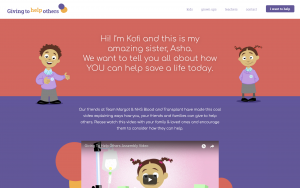
Children are encouraged to visit givingtohelpothers.org at home, with their family & loved ones. This new website contains information and links on how to sign up as a donor, as well as teacher’s notes, video animation and assembly presentation
It was fantastic for Margot’s auntie Nadia & I to see the assembly being delivered, first hand and we were also privileged to speak to some of the pupils afterwards.
Overall, we were thrilled to receive the very positive feedback from teachers, teaching assistants and pupils alike.
As a result of this initial pilot, we have tweaks to make to the content & delivery of the assembly presentation and will be beginning a more involved research programme during the course of the next several months, to trial more extensively and monitor outputs.
Our initial aim is to raise around £1 million to fund the programme development and roll out over the next 5 years and to put formal structures in place by Summer 2018.
This is a radical departure from how Team Margot Foundation has operated hitherto, as an entirely unpaid volunteer charity and we are approaching philanthropists, investors and trusts to secure the funds needed to develop & scale our education programme going forward.
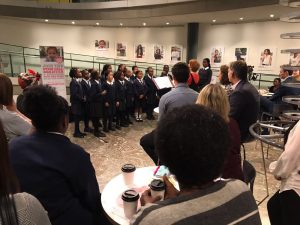
The John Ruskin School Choir started us off…
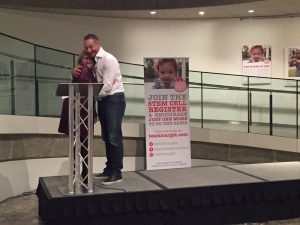
It got emotional – with Becs Palmer, who heads up the Education and Youth team’s Peer Outreach Workers
The launch of our ‘Giving To Help Others’ education programme took place during the afternoon of Monday 30 October 2017 and then later on the same day we officially launched ‘The Power of One’ photographic exhibition with City Hall’s Education & Youth Team Peer Outreach Workers (POWs).
The exhibition features portraits by photographer Cath Harries of the POWs, donors who registered because of Margot & the work of Team Margot, sickle cell patient Chanel Taylor and Margot’s Consultant, Head of Haematology at Great Ormond Street Hospital, Dr Phil Ancliff who all devote their time to encourage people within their communities to register as potential stem cell / bone marrow donors.
‘The Power of One’ photographic exhibition will remain on display at City Hall until Friday 24 November 2017.
Admission is free.
It’s difficult to convey the positivity, warmth and love in City Hall that day and in particular the convivial atmosphere during the evening session, which began with singing from the delightful John Ruskin School Choir, and which was peppered with numerous talks and Spoken Word from our co-hosts, including the unstoppable Rebecca Palmer and her team of POW’s, peripheral stem cell donors, sickle cell patients and closed by the fantastic London Community Gospel Choir, however we have tried to capture some of what happened on the day in this video.
We hope you enjoy. And share.
Thank you.
Team Margot
Together, saving lives


by Yaser
Today is 30 October – these days, I have mixed feelings about the month of October:
Our daughter, Margot died on 27 October; that was 3 years ago on Friday…
Anthony Nolan died on 21 October 1979, aged 8 – in spite of his mothers efforts – his mother, Shirley was really something; she established the worlds first bone marrow register, in her son’s name, here in the UK.
8 October is the date that Daniel de Gale, Bev & Orin’s son passed away, aged 21. Daniel was the first black person in the UK to receive a stem cell transplant from an unrelated donor.
And on 7 October Margot was diagnosed with blood cancer; that’s the reason why 7 October is now the date of Team Margot’s annual stem cell and bone marrow Registration Day.
When Margot was diagnosed with leukaemia, our family had a very steep learning curve. I learned that your bone marrow is your body’s blood factory. And with Leukaemia, the blood factory malfunctions & produces white cells in the wrong proportions, far too many, and because it’s so busy working to produce these white cells, too few of the other cells are produced – cells that we need, to stay clinically well. For example, one of the tell tale signs of leukaemia is bruising, which occurs very easily, owing to a low platelet count.
When Doctor Ancliff (who is pictured in the exhibition) told Vicki & I on our first meeting a few hours after Margot arrived at GOSH, that Margot needed a BMT to stand the best chance of survival, I didn’t know what that was. Basically, the idea is that the patients bone marrow is removed & replaced with someone else’s. I use the analogy that it’s a bit like removing your computer operating system & then reinstalling it, if it crashes.
But to have a bone marrow transplant, you first need a bone marrow donor, someone who has the same tissue type as the patient. You need the right software.
And I quickly came to understand that people from the BAME communities are disadvantaged because there aren’t enough people registered as potential stem cell donors from those communities, to meet the patient demand.
Research undertaken by Anthony Nolan – the registry – tells us that white, Northern Europeans have a 69% chance of finding their ‘perfect match’, i.e. a 10/10 antigen match. By stark comparison, people from the BAME communities have only a 21% chance of finding an equivalent match.
And the odds are worse still if, like Margot, you’re mixed race.
So your race and ethnicity is vital, literally, when it comes to bone marrow transplants.
When Nadia & I initially came to City Hall to meet the Education and Youth Team’s Peer Outreach Workers (POWs) and they learned about this, it struck a chord; the POWs embraced Team Margot and the cause and really took it on board.
As I believe you’ll find out as the evening goes on, the POWs didn’t just turn up and have their photos taken for this exhibition, but they have each registered as potential stem cell donors and have personally taken this message home, into their communities.
But then, that’s what you’d expect from City Hall’s education and youth team POWs, who are amongst the brightest lights, and are their generations thought leaders and achievers. Like everyone else at Team Margot, they want to make a difference.
And with all that said, in a sense, it’s fitting that we are still in October, because October is Black History Month.
So really, that’s what The ‘Power of One’ photographic exhibition is all about: the impact that each of us can make as individuals, on one patient, one family, one community, oneself.
Dr Daniel McCloskey is here tonight; Dr McCloskey is a tissue typing guru of 35 years – and he always says, a patient only needs one donor. And you could be that donor.
So please join the register !
The photographs in the exhibition were taken by Cath Harries; this is Cath’s very first photographic exhibition ! Many congratulations & thank you for all your support Cath. And not just with this exhibition, but with all the other Team Margot work you do too.
You’ll note that the people in the photographs are all wearing a pink Team Margot wristband – the wristbands have become synonymous with Team Margot – and they are available for anyone to take from the pink box which will remain on display in the boutique coffee shop at the bottom of the ramp, until the end of the exhibition on Friday 24 November.
No donation is required – we simply ask that people ‘register, wear and share!’
The photographs are taken in front of icon London, featuring:
– POWs
– Stem cell donors: Raj, Ros & Katrina – Raj & Ros are with us tonight; alas Katrina is now living in New Zealand; as I say, Raj will be saying a few words later
– Sickle cell patient, Chanel Taylor – we primarily campaign for bone marrow donors but we also encourage blood & organ donation too… right now, there is an urgent need for more black blood donors, because they’re more likely to carry the much needed RO subtype of blood – the Ro subtype is simply blood with a certain combination of genes. Only 2% of our donors have it – so you’re going to hear from Chanel because she will be speaking later too
And also featured is Dr Phil Ancliff, Margot’s consultant
30 October will be remembered by me both for the launch of this event but also because we presented our education programme test of concept, which we call: giving to help others. The video part of the assembly presentation is playing on a loop, with subtitles – you can find out more, please go online and visit: givingtohelpothers.org
Everything we do as team margot is about seeking to educate, inspire & motivate people to become potential bone marrow donors, blood donors & organ donors. The philosophy of ‘Giving to help others’ is at the core of what Team Margot is all about: giving a part of ourselves to try and help save a life.
Margot’s story also touches upon organ donation. Because, a few weeks before Margot died, Vicki raised the issue with me of whether we might donate Margot’s organs. I was immediately horrified at the thought – Margot had been through so much; and yet after I had calmed down and considered the matter over the course of the next few days, on an even pulse, I did a complete u turn and realised that, of course, if we could, then we should donate Margot’s organs to help another small child in their time of need. As it turns out, there was some misinformation at the time, initially we understood that we could donate Margot’s heart valves and her corneas, but later learned that anyone with a haematological disorder is unable to donate their organs.
The point of me telling you that story is, irrespective of what your views are: TALK ABOUT DONATION WITH YOUR FAMILIES AND LOVED ONES, because ultimately it will help clarify and further understanding. It can take a bit of time to get your head around these issues. So don’t delay !
Lastly, the best thing about October occurred earlier this month, on Wednesday 4 October, when the Prime Minister announced that we would be “shifting the balance of presumption in favour of organ donation.”
This is a wonderful ‘once in a generation’ opportunity to actually make new laws & bring about systemic change to improve things, and it’s a fantastic that this is now firmly on the agenda, in a political climate that’s otherwise dominated by Brexit.
So please, let’s not waste it !
Previously, I was never really a fan of the opt out process, which Wales adopted a couple of years ago, because perhaps idealistically, I always wanted people to make a positive decision, a positive affirmation and say “I WANT to be a donor”.
But unfortunately people aren’t doing that in sufficient numbers & as my wife, Vicki has always said: if the system isn’t working, then change it !
So now, I’m loudly advocating for the ‘opt out’ system and all the possibilities that it offers.
As a parting comment, I’d just ask that each of you please consider the issues, decide how you feel about donation & what your wishes are and then discuss & share them with your loved ones; and please get involved with the consultation process and share your views.
I believe that each of us has an individual social responsibility – and that’s the power of one.
Thank you all so much again.
We hope you enjoy the evening.
Husband to Vicki and father to Oscar (2007), Rufus (2008), Digby (2015), Humphrey (2017) & Margot (2012-2014)
Team Margot’s mission
To help save and improve lives by educating, inspiring and motivating people, especially from ethnically diverse communities, to register as blood, organ, stem cell and bone marrow donors and to provide a range of support to families caring for child cancer patients.
Team Margot also provides secretariat support to the All-Party Parliamentary Group for Ethnicity Transplantation and Transfusion.